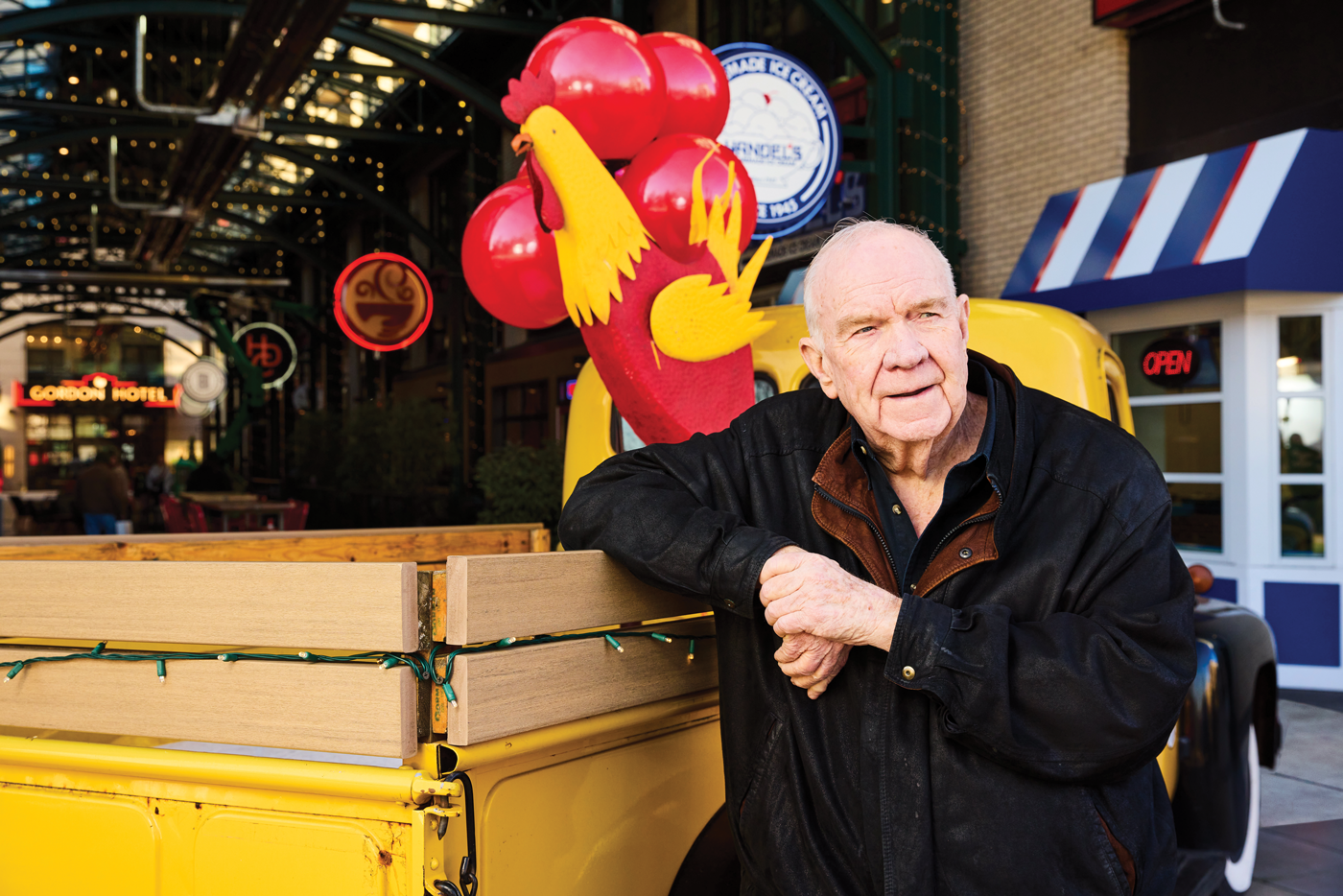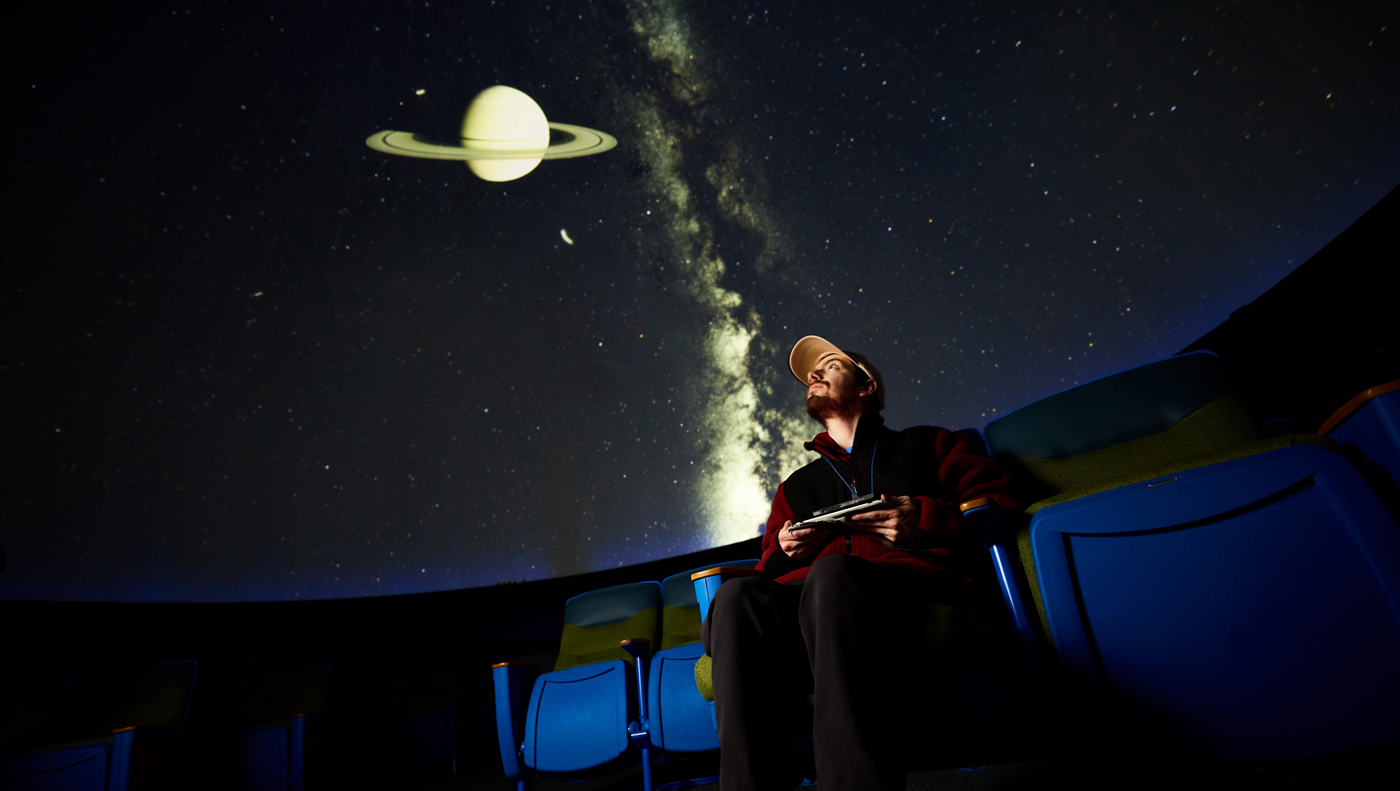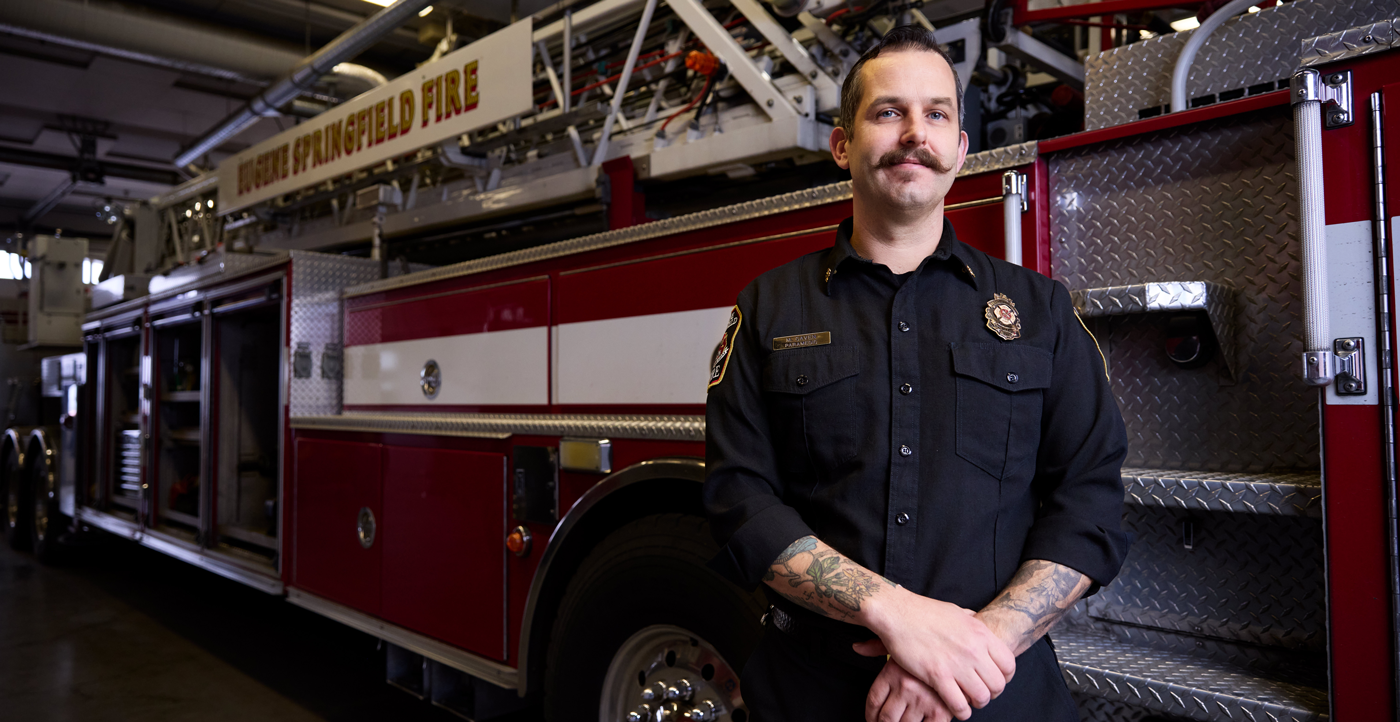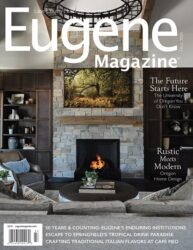Every community is shaped by the dedicated individuals who devote their careers to public service, education, and cultural enrichment. Read along as we step into the daily routines of five remarkable professionals: Springfield Mayor Sean VanGordon, who guides his city’s vision; Eugene Fire Chief Mike Caven, who ensures public safety; business leader Brian Obie, whose ventures have transformed our downtown landscape; Museum of Natural and Cultural History archaeologist Chris Ruiz, who unearths Oregon’s ancient past; and Eugene Science Center planetarium manager Kevin Davis, who helps us explore the stars. Through their stories, we’ll discover not just what drives their typical workday, but the unique paths that led them to become essential threads in our community’s fabric.

Brian Obie | Developer, Obie Companies
At 83, Brian Obie remains as driven as ever, arriving at his office by 8:30 each morning. On the day we meet, he is wearing an Obie Companies hat and shirt, carrying his coffee mug (he drinks coffee all day long), greeting everyone in the office, and asking for documents so he can stay updated on his Corvallis development. He maintains a full schedule, typically working until 5 or 6 pm. He works alongside a team typically half his age, drawing energy from their enthusiasm for his vision. When he sits at his desk, he’s surrounded by news clippings and the obituaries of friends and colleagues that line the corkboard behind his computer. These aren’t, he says, reminders of loss, but are celebrations of shared accomplishments and meaningful relationships built over decades.
Obie’s work ethic was forged in the post-World War II era, beginning at age 11 sweeping floors in his father’s sign shop. There, he found himself among recently returned veterans sharing their war stories during breaks, men who became his heroes. His parents, who came from Montana homestead families, instilled in him their hardscrabble values and required him to participate in family work from an early age. He took pride in every task.
“I loved accomplishing,” Obie recalls of those early days in the sign shop. “I loved walking into a place that was dirty, and having it clean when I leave.” This satisfaction in meaningful work, combined with appreciation from his father’s employees, helped shape his leadership philosophy of expressing gratitude to inspire others.
Now, his development company is expanding beyond Eugene, with projects underway in Corvallis, Provo, Tucson, and Boise. These developments, which he describes as “centers of activity,” integrate residential, retail, hospitality, and entertainment spaces to energize downtown areas. The success of Eugene’s Gordon Hotel, Inn at the 5th, and Market Alley has become a model, with other communities saying, “bring us one of those.”
“We do that work because it’s meaningful,” he emphasizes. “This is not about financial stuff.” He takes particular pride in the impact on Eugene, noting that every time he walks from his 5th Street Market office to the Gordon Hotel, people stop him with compliments and appreciation for what the development has meant to Eugene.
Having lived in Eugene for 62 years — and Eugene’s mayor from 1985 to 1988 — Obie remains invested in the city’s future. He sees opportunities to make Eugene “a better place to live,” particularly in addressing challenges in the old downtown area and helping those in need. When asked about slowing down, he reflects on his motivation: “I would like the limited time I have on this earth to be contributing to the society that I live in and the world I live in.”
Looking ahead, he sees more development coming to Eugene — more residential opportunities, retail, and potentially new forms of entertainment he hasn’t yet envisioned. “We talk about these things all the time,” he says with characteristic optimism. “We’ll be doing more things we don’t even know of yet.”
While acknowledging there are “fewer years ahead of me than there are behind me,” his drive to accomplish remains undiminished. “If I could do it again, I’d do it again,” he reflects, though he may do some things differently. “Not because I don’t like what I’ve done. I just wouldn’t see value doing the same thing twice.”

Chris Ruiz | Staff Archaeologist, University of Oregon & Museum of Natural and Cultural History
Chris Ruiz never imagined a childhood fascination with ghost towns would lead to a career in archaeology, but those family trips exploring abandoned mining settlements in Colorado and New Mexico sparked something that would shape his future. Today, as an archaeologist with the University of Oregon and the UO’s Museum of Natural and Cultural History, Ruiz helps preserve the state’s historical treasures, one careful excavation at a time.
“I loved the sense of history and how your imagination wanders about how people lived in the past, what they did and what their day to day life might have been like,” Ruiz reflects. “Those places fascinated me.”
Today, his work takes him to every corner of Oregon, conducting archaeological surveys and excavations for state agencies like the Oregon Department of Transportation and Parks Department. On any given day, Ruiz might be trudging through mud documenting artifacts, carefully cataloging findings in the lab, or consulting with Oregon’s tribes about significant cultural sites.
A typical project begins with extensive research about an area’s history, including its Native American heritage and early settlement patterns. Then comes the fieldwork — systematically walking the landscape in grids, identifying promising locations for ancient campsites or settlements, and sometimes conducting careful excavations. As an archaeologist, Ruiz advocates for cataloguing and preserving these archaeological resources.
“If they’re important, we want to make sure we can get information from them and about them before they’re lost to development,” Ruiz explains.
One of his most meaningful projects involved the Hannah and Eliza Gorman house in Corvallis. The mother and daughter, among the only Black women listed in the Oregon Trail roster, built their home there in the 1850s. Ruiz spent 15 years studying the property, helping get it listed on the National Register of Historic Places and uncovering archaeological evidence of earlier structures.
More recently, Ruiz co-directed excavations of a 1910s city dump near Corvallis, yielding thousands of artifacts that tell the story of daily life a century ago. Among the bottles and dishes reflecting bygone households, one tiny find stands out in his memory — a delicately hand-painted porcelain doll’s eye, along with Chinese ceramics that hint at the area’s early Asian American community.
While the work can be physically demanding — imagine trying to take detailed notes while digging in never-ending winter rain — Ruiz finds deep satisfaction in piecing together these historical puzzles. His findings don’t just sit in museum storage; they’re shared through exhibits, academic publications, conference presentations, and even informal chats at farmers markets.
“The value of what we do is protecting these important places and finding ways to share their stories with the public,” Ruiz says. “Each site helps us understand something new about Oregon’s past that we didn’t already know.”
Learn more about work like this at the Museum of Natural and Cultural History’s Meet an Archaeologist! Event, March 6, 5:30 and 7 p.m. Chat with MNCH archaeologists about their research, see artifacts, and learn more about how the past influences the present.

Kevin Davis | Planetarium Specialist, Eugene Science Center
Kevin Davis’s journey into astronomy didn’t begin with formal education, but rather with a simple desire to volunteer at the Sunriver Nature Center and Observatory in Central Oregon. Eleven years ago, without extensive knowledge of the cosmos, he was drawn to the idea of operating telescopes and educating the public about space. Through hands-on experience and collaborations with astrophysics professors and students, he developed both expertise and a lasting passion for astronomy.
Now, as a planetarium specialist at the Eugene Science Center for just over a year, Davis brings the wonders of space to life for visitors of all ages. His role involves hosting field trips for students from third grade through middle school, developing new planetarium shows, and setting up popular laser shows synchronized to music from Taylor Swift to Pink Floyd.
“Astronomy is not exactly well taught in schools,” Davis notes, explaining why he particularly enjoys fielding questions from curious visitors. His approach to creating planetarium shows reflects this educational philosophy — starting with thorough research to provide enough information to spark interest without overwhelming his audience. “Astronomy can kind of hurt your brain after a little while,” he admits. “There’s a lot of information to absorb.”
Davis is one of few individuals trained to operate planetarium equipment, a skill that helped land him his current position. As he explains, there are only four publicly available planetariums in Oregon — one in Eugene and one in Portland. While the software requires specialized knowledge, it’s not necessarily complicated to learn. The real challenge is getting access to the equipment, given how few planetariums exist.
Though he owns a telescope, Davis left it with his parents in Bend, where darker skies and less cloud cover make for better viewing conditions than Eugene. However, his enthusiasm for celestial observation remains undimmed. He particularly watches for two phenomena: the aurora borealis, which has become increasingly visible in Oregon due to an active solar cycle, and Betelgeuse, a star that could go supernova within our lifetime.
“Every time I see Betelgeuse, I sit there and stare at it for a couple moments, hoping that it will all of a sudden flash,” he says. Such an event would mark only the sixth supernova in recorded history to be witnessed without a telescope. “I’ve been watching it for a little over 10 years now,” he adds. “But any day now, you never know.”
Whether he’s creating new planetarium shows, hosting field trips, turning on Taylor Swift–inspired laser shows, or helping visitors understand recent astronomical events like comets and lunar eclipses, his work reflects a deep commitment to making astronomy accessible and engaging for everyone who visits.

Sean VanGordon | Springfield Mayor
Sean VanGordon loaded UPS trucks while studying political science at the University of Oregon. Today, he balances a full-time career in healthcare with a mostly full-time job as Springfield’s mayor, driven by a vision of the city as a “community of opportunity.”
His grandmother, a middle school social studies teacher, nurtured his interest in politics and economics. “Once you get an interest in those subjects, you start to pay attention to everything that happens around you,” he says. After serving on the planning commission and city council, he became mayor in 2021.
Monday mornings start at 5:30 with Optum Healthcare. By mid-afternoon, he’s at City Hall in meetings, reviewing issues, and preparing for evening council sessions that can run until 8:30. Other days require library board meetings, community events, or working on infrastructure projects.
While city manager Nancy Newton handles daily operations, VanGordon helps set vision and policy. Current priorities include the decades-in-the-making Glenwood redevelopment, critical levy repairs protecting North Springfield from flooding, and implementing a newly-passed street bond.
“Sometimes it takes a lot of time to get things done,” he notes. “You’ve got to really commit to people and to seeing things through.”
2024 brought challenges and triumphs. After a devastating January ice storm, VanGordon witnessed the community’s resilience firsthand. “I was so proud of how neighbors really took care of each other,” he says.
The year also saw the dedication of a memorial plaque to a fallen airman, a Medal of Honor awarded to a Springfield police officer, and successful community events such as the downtown block party and Christmas parade. His proudest achievement is a simple but impactful program ensuring every child in the school district gets a library card, regardless of city residency. “This speaks to how this community values literacy,” he says. “It’s very practical but requires partnership between the school district and city. We’re all working together to make sure kids have access to materials.”
For VanGordon, it all comes back to building that community of opportunity: “People need a place where they’re going to feel like when they work hard, it’s going to pay off. They can find housing, find a good career, the streets are safe, infrastructure is invested in, and they have a place to take their family. That’s ultimately what my role is — to help us serve the public.”
Mayor VanGordon also leads a busy home life, with two 8-year-old twin daughters he calls “the Wonder Twins.” His mother is a twin and his brother also has twins. He is quick to say that he could not manage all that he does without support from his spouse, Elaine. “I live a busy life with a lot of scheduling and a lot of coordination,” he says. “More work for me also means more work for Elaine.”

Mike Caven | Eugene Fire Chief
Mike Caven’s grandmother volunteered in the emergency room and always talked about Eugene firefighters. After experiencing a house fire at a young age, those early stories of first responders helping people in crisis sparked a passion that would shape his career.
For a writing assignment while in first grade in Redmond, he wrote to the Eugene Fire Department asking for a team photo (he had just started playing baseball). They sent a patch with an apology, “we don’t do team pictures, but come see us when you’re 18.” Thirty-five years later, Caven leads that same department as fire chief, overseeing emergency responses across a population of about 260,000 in the greater Eugene-Springfield area.
“Within the first six months of being in this role as the chief, I got one of those letters sent to me from a school in Utah, and I was elated to write back to this little girl with my story of ‘I did this when I was your age,’” Caven recalls.
Starting as a firefighter paramedic in Cottage Grove, Caven transferred to Eugene in 2007. He worked his way up through the ranks, from firefighter to engineer driving fire trucks to a captain leading a crew on a ladder truck downtown, then battalion chief supervising multiple stations. Along the way, he served as president of the Lane Professional Firefighters Association before becoming chief in 2022.
His days start about 7 a.m., though emergency calls can wake him at any hour. He manages 340 staff responding to 50,000 annual calls while juggling meetings with two city councils and executive teams since Eugene and Springfield’s fire services are merged but maintain separate budgets.
“We’re an incredibly busy fire department when we stack up against our peers,” Caven explains. While fire calls have decreased as a percentage of responses, they continue to climb and the total volume has exploded. “Eugene hasn’t added firefighters in over 40 years, with a 1,000% increase in call volume in that time frame,” he notes.
Most calls are medical emergencies, not actual fires, with fire trucks responding because they carry paramedics and the same lifesaving equipment as ambulances. With only 10 ambulances serving both cities, these additional resources are critical. Fire crews shoulder a huge burden of healthcare access calls while dealing with trauma, with no time to decompress in between.
Caven still occasionally rides along on calls to stay connected with his crews’ experiences. During one recent four-hour shift, he witnessed the intensity firsthand: “It went bam, bam, bam — from a death investigation to a mental health crisis to helping someone in challenging living conditions. It was a reminder of what our crews face on any given day.”
Despite the challenges of tight budgets and increasing demands, Caven remains driven by the same mission that inspired that childhood letter — serving his community when they need help most.


